Abstract
Expression of CD4 or CD8 on the cell surface is an important guide for discriminating the immunological functions of T cells. However, a minor T cell subset, which lacks both CD4 and CD8 molecules but bears the usual form of T cell receptor (TCR) alpha beta (CD4-CD8-TCR alpha beta+ T cells), has recently been found not only in mice but also in humans, and its role in immune response is now of considerable interest. In order to clarify the characteristics of this newly defined T cell subpopulation, we established five IL-2-dependent CD4-CD8-TCR alpha beta+ T cell clones from the peripheral blood of a healthy individual, and examined their various biological functions. It was found that all clones not only helped B cells in immunoglobulin production, but also exerted major histocompatibility complex-unrestricted cytotoxicity. Although their CD3/TCR complexes were functionally competent, the cytotoxicity seemed to be mediated via unknown molecules other than the CD3/TCR complex, as evidenced by the failure of CD3 MoAb to inhibit the cytotoxic activity. Our present findings showed that CD4-CD8-TCR alpha beta+ T cells possess potential bifunction, i.e. helper and cytotoxic activities. Their roles in the pathogenesis of immunodeficiency are discussed.
Full text
PDF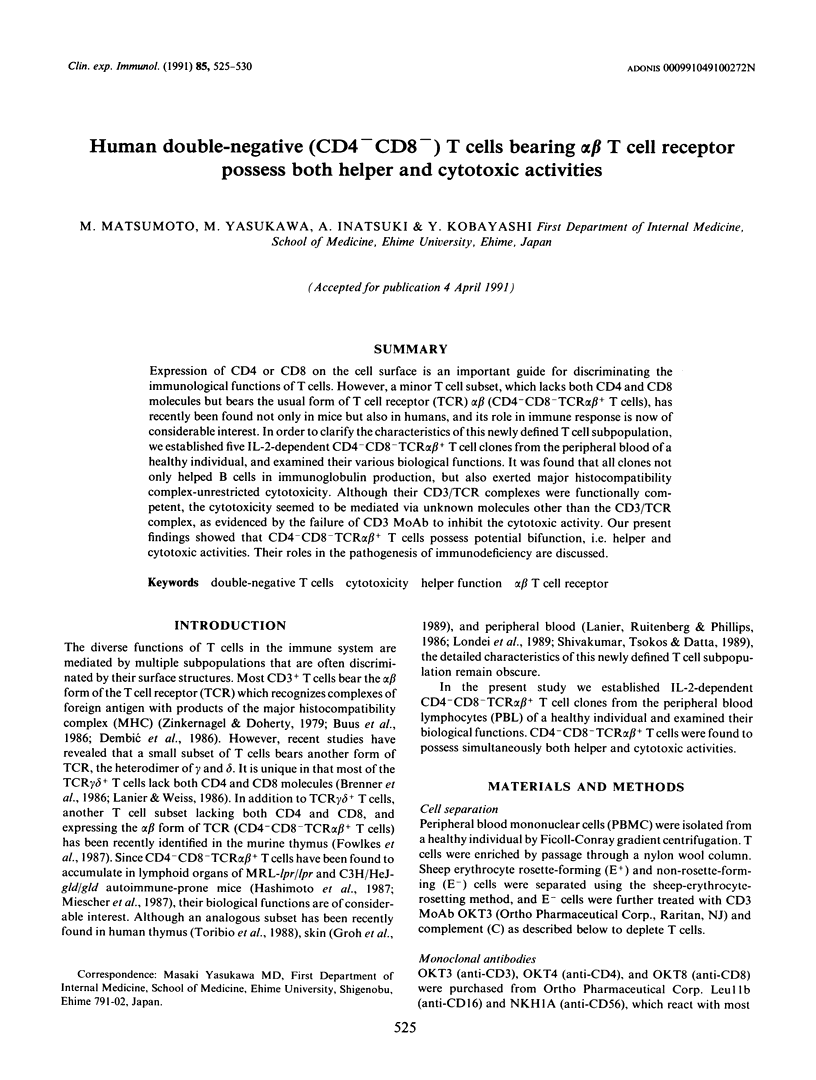
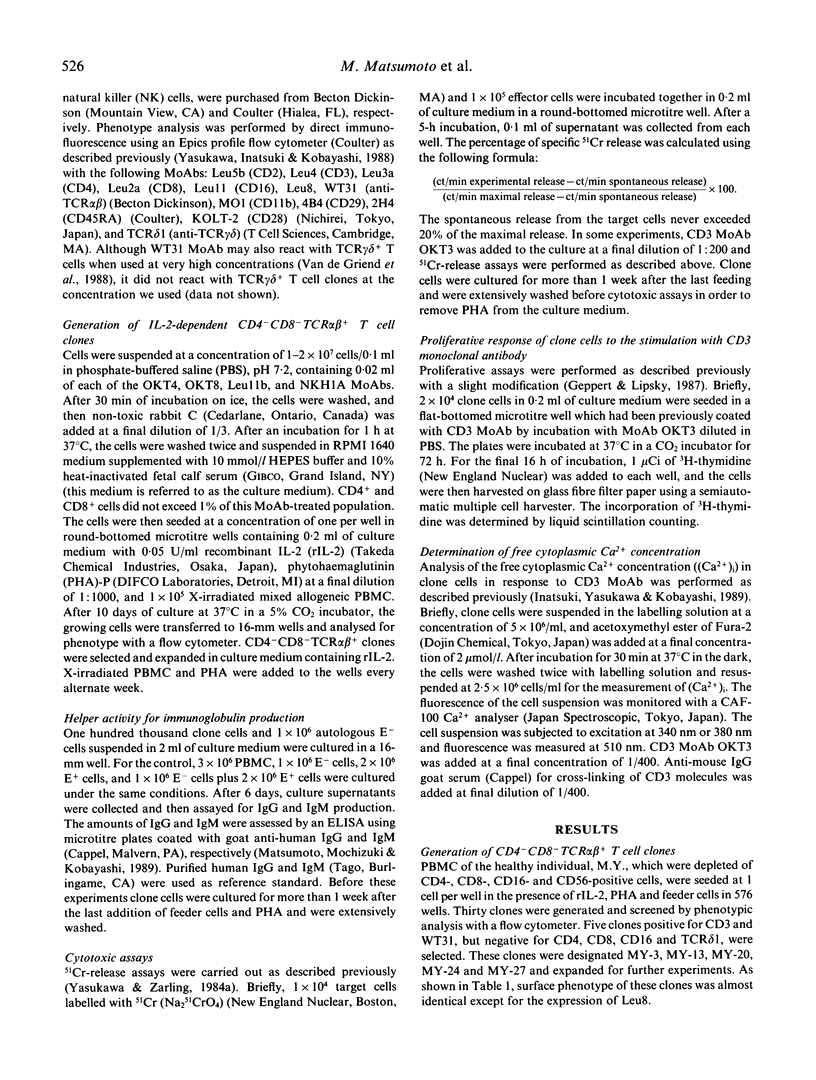
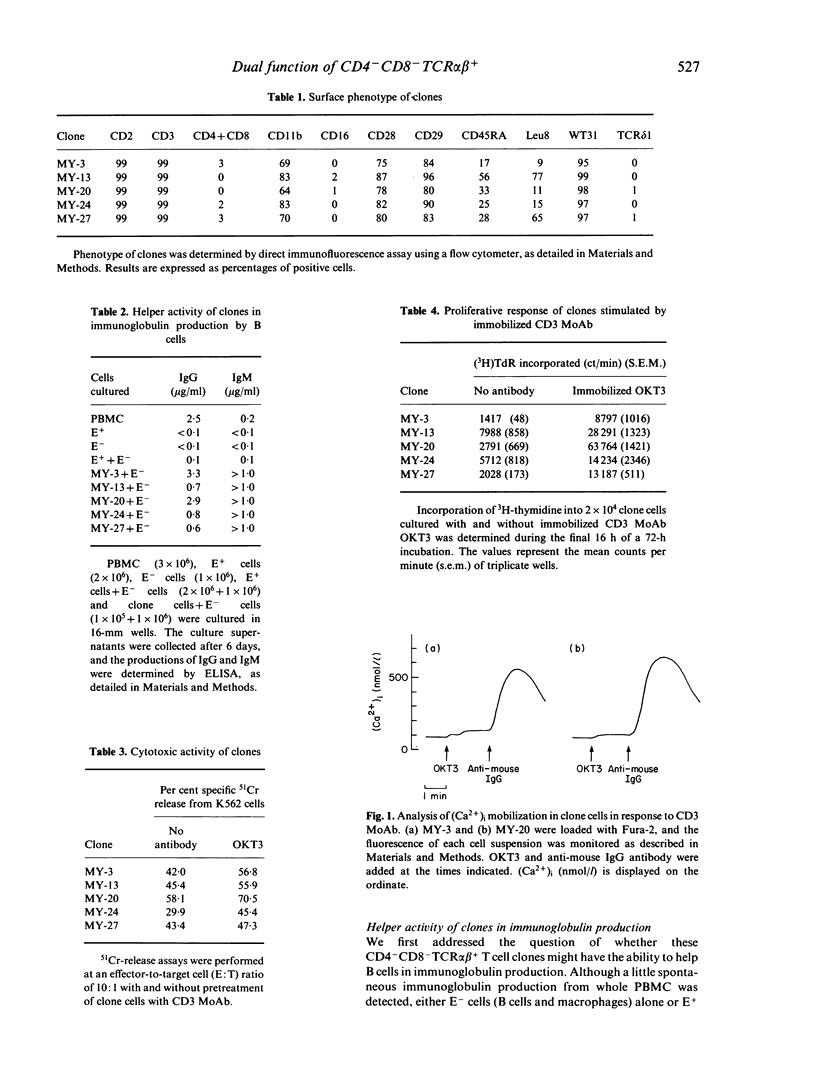
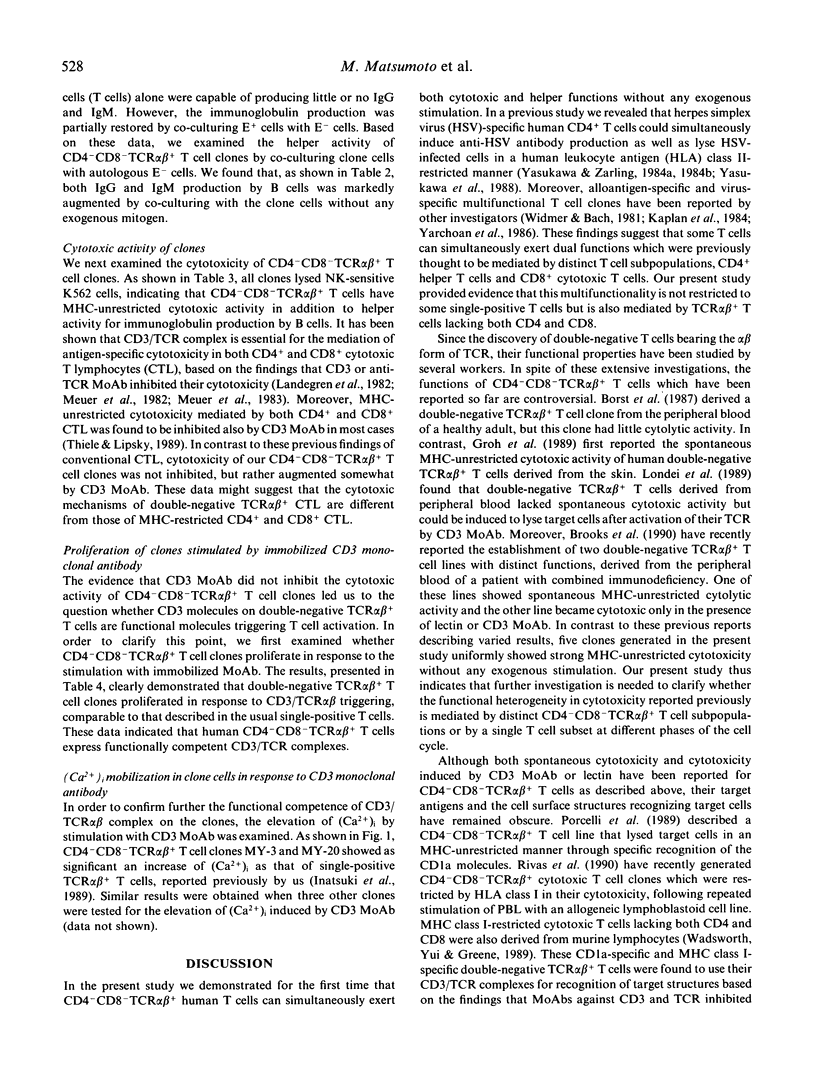
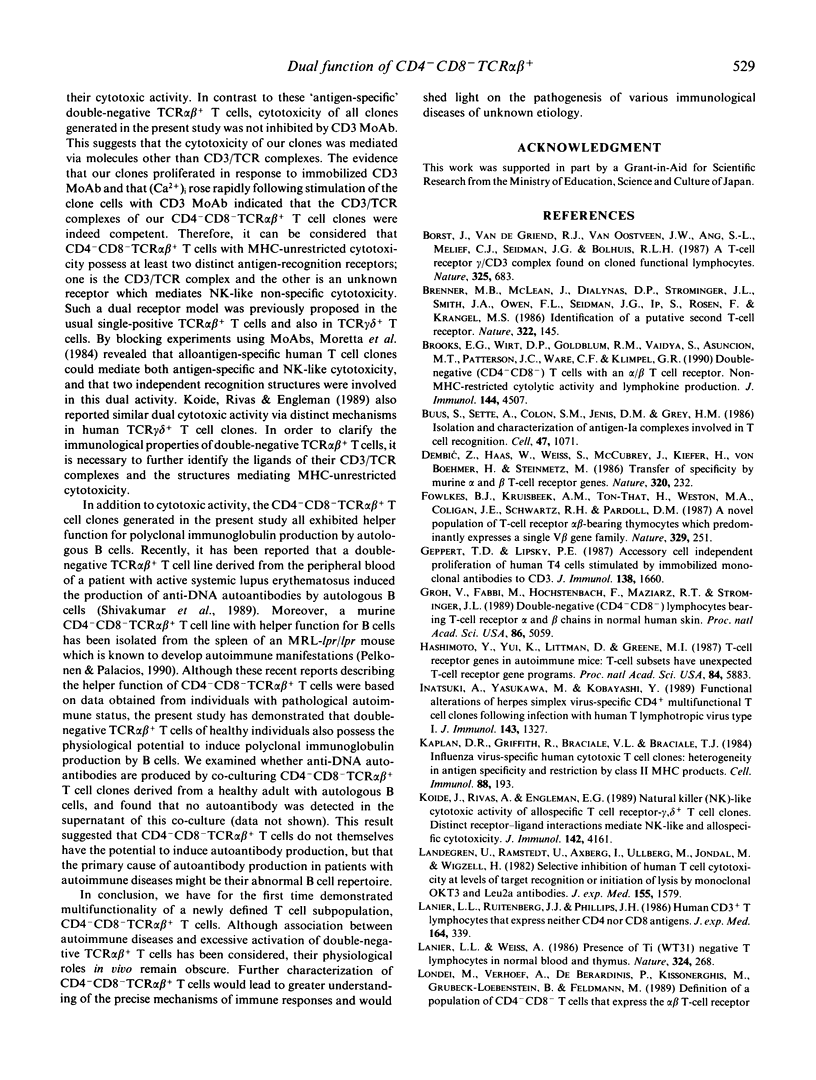
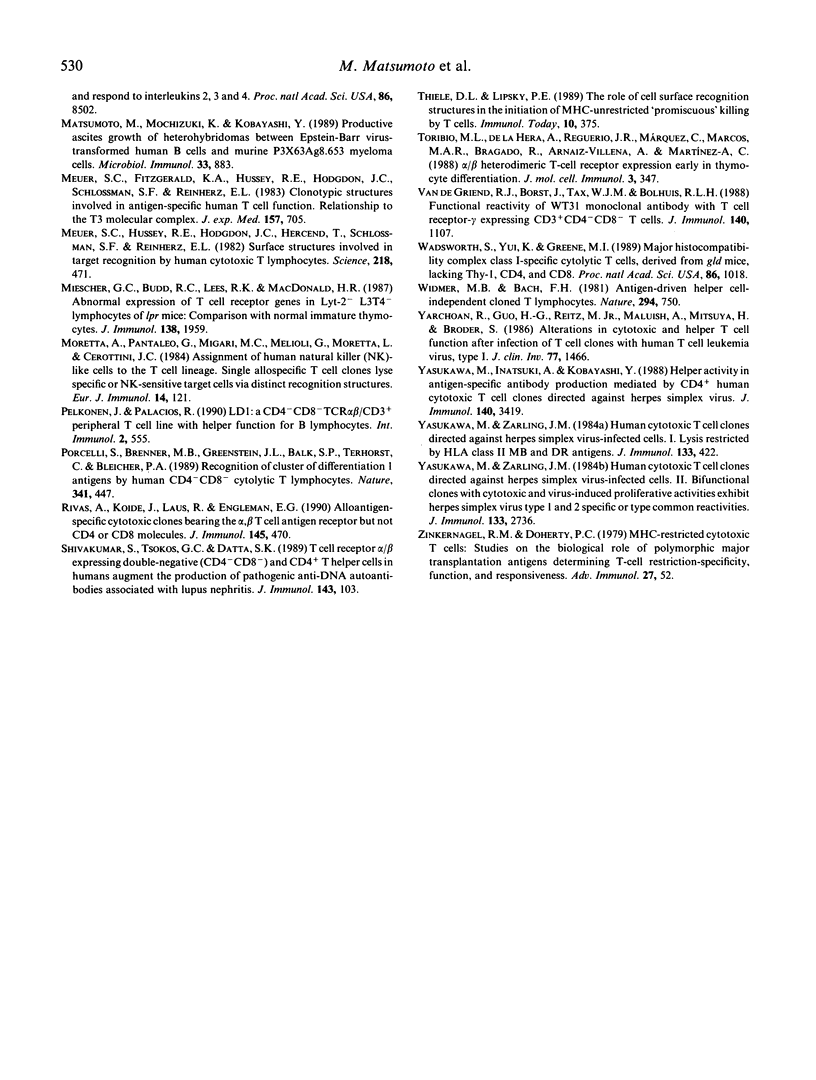
Selected References
These references are in PubMed. This may not be the complete list of references from this article.
- Borst J., van de Griend R. J., van Oostveen J. W., Ang S. L., Melief C. J., Seidman J. G., Bolhuis R. L. A T-cell receptor gamma/CD3 complex found on cloned functional lymphocytes. Nature. 1987 Feb 19;325(6106):683–688. doi: 10.1038/325683a0. [DOI] [PubMed] [Google Scholar]
- Brenner M. B., McLean J., Dialynas D. P., Strominger J. L., Smith J. A., Owen F. L., Seidman J. G., Ip S., Rosen F., Krangel M. S. Identification of a putative second T-cell receptor. Nature. 1986 Jul 10;322(6075):145–149. doi: 10.1038/322145a0. [DOI] [PubMed] [Google Scholar]
- Brooks E. G., Wirt D. P., Goldblum R. M., Vaidya S., Asuncion M. T., Patterson J. C., Ware C. F., Klimpel G. R. Double-negative (CD4- CD8-) T cells with an alpha/beta T cell receptor. Non-MHC-restricted cytolytic activity and lymphokine production. J Immunol. 1990 Jun 15;144(12):4507–4512. [PubMed] [Google Scholar]
- Buus S., Sette A., Colon S. M., Jenis D. M., Grey H. M. Isolation and characterization of antigen-Ia complexes involved in T cell recognition. Cell. 1986 Dec 26;47(6):1071–1077. doi: 10.1016/0092-8674(86)90822-6. [DOI] [PubMed] [Google Scholar]
- Dembić Z., Haas W., Weiss S., McCubrey J., Kiefer H., von Boehmer H., Steinmetz M. Transfer of specificity by murine alpha and beta T-cell receptor genes. Nature. 1986 Mar 20;320(6059):232–238. doi: 10.1038/320232a0. [DOI] [PubMed] [Google Scholar]
- Geppert T. D., Lipsky P. E. Accessory cell independent proliferation of human T4 cells stimulated by immobilized monoclonal antibodies to CD3. J Immunol. 1987 Mar 15;138(6):1660–1666. [PubMed] [Google Scholar]
- Hashimoto Y., Yui K., Littman D., Greene M. I. T-cell receptor genes in autoimmune mice: T-cell subsets have unexpected T-cell receptor gene programs. Proc Natl Acad Sci U S A. 1987 Aug;84(16):5883–5887. doi: 10.1073/pnas.84.16.5883. [DOI] [PMC free article] [PubMed] [Google Scholar]
- Inatsuki A., Yasukawa M., Kobayashi Y. Functional alterations of herpes simplex virus-specific CD4+ multifunctional T cell clones following infection with human T lymphotropic virus type I. J Immunol. 1989 Aug 15;143(4):1327–1333. [PubMed] [Google Scholar]
- Kaplan D. R., Griffith R., Braciale V. L., Braciale T. J. Influenza virus-specific human cytotoxic T cell clones: heterogeneity in antigenic specificity and restriction by class II MHC products. Cell Immunol. 1984 Oct 1;88(1):193–206. doi: 10.1016/0008-8749(84)90064-9. [DOI] [PubMed] [Google Scholar]
- Koide J., Rivas A., Engleman E. G. Natural killer (NK)-like cytotoxic activity of allospecific T cell receptor-gamma,delta+ T cell clones. Distinct receptor-ligand interactions mediate NK-like and allospecific cytotoxicity. J Immunol. 1989 Jun 15;142(12):4161–4168. [PubMed] [Google Scholar]
- Landegren U., Ramstedt U., Axberg I., Ullberg M., Jondal M., Wigzell H. Selective inhibition of human T cell cytotoxicity at levels of target recognition or initiation of lysis by monoclonal OKT3 and Leu-2a antibodies. J Exp Med. 1982 May 1;155(5):1579–1584. doi: 10.1084/jem.155.5.1579. [DOI] [PMC free article] [PubMed] [Google Scholar]
- Lanier L. L., Ruitenberg J. J., Phillips J. H. Human CD3+ T lymphocytes that express neither CD4 nor CD8 antigens. J Exp Med. 1986 Jul 1;164(1):339–344. doi: 10.1084/jem.164.1.339. [DOI] [PMC free article] [PubMed] [Google Scholar]
- Lanier L. L., Weiss A. Presence of Ti (WT31) negative T lymphocytes in normal blood and thymus. Nature. 1986 Nov 20;324(6094):268–270. doi: 10.1038/324268a0. [DOI] [PubMed] [Google Scholar]
- Londei M., Verhoef A., De Berardinis P., Kissonerghis M., Grubeck-Loebenstein B., Feldmann M. Definition of a population of CD4-8- T cells that express the alpha beta T-cell receptor and respond to interleukins 2, 3, and 4. Proc Natl Acad Sci U S A. 1989 Nov;86(21):8502–8506. doi: 10.1073/pnas.86.21.8502. [DOI] [PMC free article] [PubMed] [Google Scholar]
- Matsumoto M., Mochizuki K., Kobayashi Y. Productive ascites growth of heterohybridomas between Epstein-Barr virus-transformed human B cells and murine P3X63Ag8.653 myeloma cells. Microbiol Immunol. 1989;33(10):883–886. doi: 10.1111/j.1348-0421.1989.tb00975.x. [DOI] [PubMed] [Google Scholar]
- Meuer S. C., Fitzgerald K. A., Hussey R. E., Hodgdon J. C., Schlossman S. F., Reinherz E. L. Clonotypic structures involved in antigen-specific human T cell function. Relationship to the T3 molecular complex. J Exp Med. 1983 Feb 1;157(2):705–719. doi: 10.1084/jem.157.2.705. [DOI] [PMC free article] [PubMed] [Google Scholar]
- Meuer S. C., Hussey R. E., Hodgdon J. C., Hercend T., Schlossman S. F., Reinherz E. L. Surface structures involved in target recognition by human cytotoxic T lymphocytes. Science. 1982 Oct 29;218(4571):471–473. doi: 10.1126/science.6981845. [DOI] [PubMed] [Google Scholar]
- Miescher G. C., Budd R. C., Lees R. K., MacDonald H. R. Abnormal expression of T cell receptor genes in Lyt-2- L3T4- lymphocytes of lpr mice: comparison with normal immature thymocytes. J Immunol. 1987 Mar 15;138(6):1959–1967. [PubMed] [Google Scholar]
- Moretta A., Pantaleo G., Mingari M. C., Melioli G., Moretta L., Cerottini J. C. Assignment of human natural killer (NK)-like cells to the T cell lineage. Single allospecific T cell clones lyse specific or NK-sensitive target cells via distinct recognition structures. Eur J Immunol. 1984 Feb;14(2):121–125. doi: 10.1002/eji.1830140204. [DOI] [PubMed] [Google Scholar]
- Pelkonen J., Palacios R. LD1: a CD4-CD8- TCR alpha beta/CD3+ peripheral T cell line with helper function for B lymphocytes. Int Immunol. 1990;2(6):555–562. doi: 10.1093/intimm/2.6.555. [DOI] [PubMed] [Google Scholar]
- Porcelli S., Brenner M. B., Greenstein J. L., Balk S. P., Terhorst C., Bleicher P. A. Recognition of cluster of differentiation 1 antigens by human CD4-CD8-cytolytic T lymphocytes. Nature. 1989 Oct 5;341(6241):447–450. doi: 10.1038/341447a0. [DOI] [PubMed] [Google Scholar]
- Rivas A., Koide J., Laus R., Engleman E. G. Alloantigen-specific cytotoxic clones bearing the alpha,beta T cell antigen receptor but not CD4 or CD8 molecules. J Immunol. 1990 Jul 15;145(2):470–476. [PubMed] [Google Scholar]
- Shivakumar S., Tsokos G. C., Datta S. K. T cell receptor alpha/beta expressing double-negative (CD4-/CD8-) and CD4+ T helper cells in humans augment the production of pathogenic anti-DNA autoantibodies associated with lupus nephritis. J Immunol. 1989 Jul 1;143(1):103–112. [PubMed] [Google Scholar]
- Thiele D. L., Lipsky P. E. The role of cell surface recognition structures in the initiation of MHC-unrestricted 'promiscuous' killing by T cells. Immunol Today. 1989 Nov;10(11):375–381. doi: 10.1016/0167-5699(89)90271-5. [DOI] [PubMed] [Google Scholar]
- Toribio M. L., de la Hera A., Regueiro J. R., Márquez C., Marcos M. A., Bragado R., Arnaiz-Villena A., Martínez C. Alpha/beta heterodimeric T-cell receptor expression early in thymocyte differentiation. J Mol Cell Immunol. 1988;3(6):347–362. [PubMed] [Google Scholar]
- Wadsworth S., Yui K., Greene M. I. Major histocompatibility complex class I-specific cytolytic T cells, derived from gld mice, lacking Thy-1, CD4, and CD8. Proc Natl Acad Sci U S A. 1989 Feb;86(3):1018–1022. doi: 10.1073/pnas.86.3.1018. [DOI] [PMC free article] [PubMed] [Google Scholar]
- Widmer M. B., Bach F. H. Antigen-driven helper cell-independent cloned cytolytic T lymphocytes. Nature. 1981 Dec 24;294(5843):750–752. doi: 10.1038/294750a0. [DOI] [PubMed] [Google Scholar]
- Yarchoan R., Guo H. G., Reitz M., Jr, Maluish A., Mitsuya H., Broder S. Alterations in cytotoxic and helper T cell function after infection of T cell clones with human T cell leukemia virus, type I. J Clin Invest. 1986 May;77(5):1466–1473. doi: 10.1172/JCI112459. [DOI] [PMC free article] [PubMed] [Google Scholar]
- Yasukawa M., Inatsuki A., Kobayashi Y. Helper activity in antigen-specific antibody production mediated by CD4+ human cytotoxic T cell clones directed against herpes simplex virus. J Immunol. 1988 May 15;140(10):3419–3425. [PubMed] [Google Scholar]
- van de Griend R. J., Borst J., Tax W. J., Bolhuis R. L. Functional reactivity of WT31 monoclonal antibody with T cell receptor-gamma expressing CD3+4-8- T cells. J Immunol. 1988 Feb 15;140(4):1107–1110. [PubMed] [Google Scholar]


